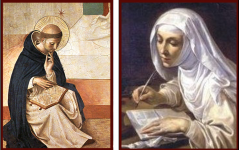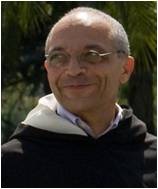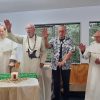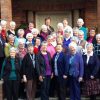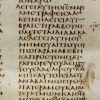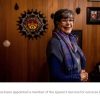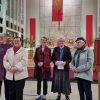 DOMINICAN LAITY
DOMINICAN LAITY
Newsletter #13
October 2010
Dear members of the New Zealand Dominican family
News in brief:
We are thankful to Fr Neil Darragh for the series of wonderful workshops on the Future of the Church in New Zealand. As always with Fr Neil, his talks were challenging, and the discussions invited us to think deeply of our own place in the Church.
Tui Motu continues on its searching for Truth in every facet of human life, now with Fr Kevin Toomey OP as its editor. The October edition is well up to what we expect, with splendid articles on Mary MacKillop, the importance of water resources, alternatives to war and violence, and Fr Neil Darragh’s take on the new Missal.
The Friars have chosen a new Master of the Order to lead for the next nine years. He is Brother Bruno Cadoré. He is a Frenchman, a medical doctor, a theologian who specialises in medical ethics.
Fr Bruno Cadoré OP
The sisters hold their General Chapter in Dunedin on 8-9 January 2011. Lay people are welcome to attend the two days of exploring the theme: Dominicans – a Family of Contemplative Preachers. American presenters Ann Willits OP and Matt Walsh OP will lead the sessions.
Organisation of the lay branch of the Dominican family has been a little slow to get off the ground, for a variety of reasons. However, a start has been made – more news later!
The lay group charged with exploring what kind of Dominican formation process for lay people is best suited to New Zealand has begun gently, by considering some of the wise discussion in the book Dominican Spirituality, by Belgian lay theologian Erik Borgman. (Chapter 23 of this book was attached to the very first of our newsletters – if you would like a copy, contact us). Part of the process will be to invite people interested in the Dominican formation process to contribute and comment on notes that the group produces. If you would like to be part of this “sounding-board” , you would be most welcome – just let us know.
Dominican Thought for the Week
The Dominican Family is our common home….One of our biggest challenges is building a shared consciousness of the Order as the place where we all belong…
Many little tensions within the Dominican Family, such as who can put which initials after their names, who can wear the habit and when, are symptoms of this more important and deeper longing, for friendship, for a home, to belong, to have one’s assured place at the table or around the cooking pot. In the past we used to belong to the First, Second and Third Order. This terminology was abolished at the General Chapter of RiverForest in 1968, to make plain our equality. No one is first or second or third class. Together we must find ways to build that common home.
And it should be an open home, which welcomes the friends of our friends, which welcomes new groups whose Dominican identity is not, perhaps, clear, but who want to be part of the Family. The friendship that Jesus offers is wide and open. He welcomes in everyone. He gets impatient when the disciples try to stop someone preaching because they do not belong to the group of the disciples. He does not shut doors, but bursts through them. Let us embody that big-hearted friendship, Dominic’s magnanimity. Let us be a sign of that welcome, so that we may all be at ease in Dominic’s Family. May Dominic liberate us from the fear that locks the doors.
Timothy Radcliffe OP, in I Call You Friends, Continuum, P.158f
Young Dominicans: hope for the future
Selina Phillips is a Year 13 student at St Dominic’s College, Auckland. She has written about her experience of a get-together of Australasian Dominican schools in Melbourne. And then, at a recent Dominican gathering in New Zealand, she spoke about how the Dominican tradition has affected how she sees her life and her future.
Dominicans in Melbourne.
On the first of July, I, along with the St Dominic’s Head Girl Te Aorangi and one of our teachers, flew to Melbourne, Australia to attend the Common Ground conference for 2010. The idea of this conference was to bring together Dominican schools from across Australia and New Zealand for 3 days to find a common ground – that is, share our experiences of living a Dominican life and learn of new ways to live out the values that our founding father left us as his legacy. We came from all over- Melbourne, Sydney, Adelaide, Brisbane and of course New Zealand, all with different ways of learning, different ways of celebrating and different ways of living. But we had one main thing that made us the same- our faith and core values. It was comforting to be in a foreign country and see our motto “Veritas” on other schools crests and to see the Dominican shield used as a key symbol. Throughout the conference, we learnt more about the other schools attending, made our own special journal out of balsa wood and were led through activities by teachers and sisters that taught us more about our special character and history as students at Dominican schools. There were also plenty of opportunities to talk to the other students and talk more about our schools and life experiences, to make friends and find our common ground. By the time the conference was over, I had come to the realization of how big the Dominican movement actually is. When you live in a country as small and isolated as New Zealand, sometimes it is easy to forget the vastness of the world outside. But by attending this conference, I was about to understand that our little school is part of something big and wonderful, something that has been there for a long time, and will continue to be for a very long time. And it’s something that connects us to people all over the world. Sister Elizabeth, one of the nuns that spoke at the conference, informed us that there are over 150 countries in which the Dominican mission is alive and active. To me, that places who we are as a school community on a bigger scale, knowing that as Dominicans, we can always find other Dominicans all over the world. The common ground conference brought us Australian and New Zealand Dominicans together, and showed us all that through the establishment of common ground and honoring what ties us together, we make our world a smaller closer place of love, thereby truly living like Dominic.
2. Living like Dominic
To be Dominican is rather special. We can say that we have eight hundred years of tradition behind us. Eight hundred years of people such as Catherine of Siena and Dominic who have led the way for us as shining examples of truly living the Dominican life. And in my five years spent at St Dominic’s College, I have learnt many things. I have learnt what it means to be Dominican. To me, being Dominican is to be a strong example to others, to be truthful and to be compassionate. I feel that these values will take me well beyond my time at Saint Dominic’s and into the future.
Firstly I think that to be Dominican is to be a strong example and lead the way for others. Like our founding father, Dominic, a Dominican is expected to be willing to put themselves in front and show others how to live a life that is in service to others and to the lord. As Dominic wished to “Set the world on fire” by leading from the front and sharing the gospel, living it in word and action, so are we Dominicans expected to do the same. As a senior student, I can say the St Dominic’s has taught me to lead as an example to the youngers students on how to be a Dominican and to live the core values of Christianity. And when I leave this school, I will continue to lead and be an example of living the gospel and its value, like Dominic did so many years ago.
Secondly, a major part of being Dominican is to be truthful. The motto of our school is “VERITAS” or “Truth” and as Dominicans we are expected to be truthful in all we say and do. Catherine of Siena spoke out truthfully against the problems of her time and we are expected to do the same. This value is something that I can take beyond my time at St Dominic’s as in our society there is always room to speak the truth. And as I wish to be a lawyer or journalist further down the line, ensuring that the truth is always spoken will be a major skill required in my future professions- a skill that is a major part of my identity now as a Dominican student
Finally to be a Dominican is to be compassionate. Like St Rose, who devoted her life to the poor, we are called upon to be as Christ to our fellow human beings. Here at school, we are taught through our work with Caritas and other such aid agencies, we are reminded of our duty to care for our fellow people. This simple value of compassion is one that would take me far beyond my time here, as it is a value that society is in dire need of.
So to conclude, to be Dominican is something that I consider to be an honour. As a student at the only Dominican school in New Zealand, I am truly proud of my heritage. The Dominican faith has produced many great people such as Dominic, Catherine, Margaret and Rose- People who had embodied the core values of the faith and lived their lives as examples of the faith to us all. The values that it takes to live a Dominican life are values that I feel I can take well beyond my time here, and can pass down to my children and grandchildren so that the life of our faith can never be diminished.
Selina Phillips
Ministry on Great Barrier Island
Judith Crimmins is a lay member of the Dominican preaching team. For the last eight years Judith has been visiting GreatBarrierIsland every second month to conduct a Sunday liturgy. Here she writes about her experiences. She has also provided her scripture reflection to be given on Great Barrier this Sunday, 17 October 2010.
I have been asked to write about my preaching experience on Gt Barrier Island at St John’s Community Church.
But first a little about Gt Barrier and the Church there. The first recorded visit by a Catholic priest to Gt Barrier Island was in 1841 when Jean Pezant SM baptised 4 people and married two of them. The Archives don’t indicate whether or not he became resident there. From 1910 -1915 the Kauri Timber Company operated a large timber mill at Whangaparapara. During the summer of 1912-1913 two Sisters of St Joseph went there to give instruction and visitation. They stayed with the family of the General Manager of the mill – the Smiths who were Catholic. A church was erected on the mill site and opened by Bishop Cleary on February 17th 1913. At this time Fr Gilbert Tigar OP took charge for 2 years. There was a steady congregation of a hundred on Sundays. When the mill closed down in 1915 the island was mainly looked after by Puhoi. There I no trace of that church there now.
Today the Church community on Gt Barrier is truly ecumenical hence the name St John’s Community Church. There is a joint use agreement among the Anglican, Catholic, Methodist and Presbyterian Churches where, amongst other responsibilities each agrees to take turns in leading the Sunday service. The celebrations of the 20th jubilee of the Community Church reflected this ecumenism with all ministers from the mainland attending and taking part in the ceremony.
For the past 23years Fr Terry Dibble has served the community there by going every two months. There are about 700 permanent residents. Needless to say most don’t come to church but I have heard non-church people talk about ‘our’ church and so the presence of the church there seems to have some impact. One being a community garden initiative on the church land and people can attend gardening classes there conducted from the Northland Technical Institute. ST John’s always has a float in the annual Christmas Parade – usually the only one with a Christmas theme! The design of this particular one was devised by a creative parishioner. Santa Claus who was riding a Crazyhorse Trike stated that 2 wise women were worth more that 3 wise men any day! We agreed wholeheartedly!
There are at least 2 other worshipping communities – They seem to be Pentecostal and Fundamentalist. There is a little interaction from time to time between the three.
In 2002 Terry asked me if I would go down and lead Liturgy of the Word with Holy Communion. Some Dominican Sisters had been going for some years:- Sister Loreta Meehan OP, Sisters Claire OP and Joan Tympany rgs. All are remembered with much love.
That first time I went to the Barrier was Palm Sunday. I spent the Saturday getting to know some of the people and ensuring that we had good speakers for the gospel reading. . Evidence of ecumenism was on my first trip there when I was concerned re the hymns. ‘How will these ones be?’ I asked. ‘Will the people know them? they may bit Catholic….’ The musician replied. ‘This week you’re leading the service and we follow you; last week was the Presbyterians and we follow them; next week is the Methodists and we follow them. At the end of one lengthy conversation I suddenly realized that I was being quizzed about myself as near the end it was said ‘You are a friend of Terry’s and so you must be OK’!!!!! Initially I was extremely nervous but as so often happens, familiarity decreases the nervousness and I am now accepted as a part of the Gt Barrier Church Community. There is no doubt about Terry Dibble’s impact on the island. It is rare to talk to anyone in the secular world there who does not know him. Many people seek his assistance both on the island and when in hospital in Auckland. Pastoral work of course goes with the territory both on and off the Barrier!
Preaching “What is preaching?”
IN any preaching it is important to have some idea of the life of the community and to link this into the homily. Islanders generally lead a subsistence and isolated lifestyle. Although there are planes every day and a ferry service 2 or 3 times a week travel to the mainland is expensive. A common topic of conversation at the dinner table is on the most economical way of obtaining food items from Auckland. The congregation is small; the pressures in their lives and the things that concern them are very different from those of us on the mainland.
For each Sunday I make a leaflet that indicates the various parts of the Mass so that everyone, no matter what tradition, can take part easily. It includes the introductory prayers and blessings that reflect the readings of the day and also includes the Psalm of the day. At times relevant responsorial type prayer in bookmark or other forms are included. There are times when particular people receive special blessings during the liturgy eg newly elected Council Board Member; the bereaved, the sick, birthdays and similar events. Articles on topical issues from journals such as Tui Motu are also distributed.
Every time I go to Gt Barrier Island something special or quite different happens. A retired violinist from the Sydney Symphony Orchestra sometimes comes and so we could have classical music after Communion; or the family from Fiji may bring their music; or Carleen may encourage her 3 little girls to sing an interactive hymn.
I could use many examples of preaching but one that always comes to my mind is as follows:
Gemma (a lively 13 yr old Downs Syndrome girl) arrived with her mother Mary who was the leader of the music. As I was preparing for the liturgy Gemma bounces in with a CD and excitedly asks if we could play her new Celine Dion CD during the liturgy – (Mary obviously had no idea about Gemma’s plan). Well, I thought, this is the Gt Barrier community – not mine – Gemma is part of it so who am I to say no. Hence my reply ‘Yes – but only one track if you can find a CD player.’ Well there wasn’t one. Each Sunday begins with songs of praise and as Mary led us on the guitar Gemma started dancing around the back of the altar and I silently thought we’re going to have a jack in the box act soon. Her mother obviously thought similarly and so she stopped the music, reprimanded Gemma (which took some doing!) and ordered her away from the altar.
All was quiet for awhile and we continued with the readings. They were about a Ruler. Gemma disappeared into the storage room where the children’s dress-up box was and we all continued with the liturgy. Then, when I was giving the homily, Gemma reappeared dancing down the aisle with an old red curtain draped around her like a cloak and wearing a cardboard crown. She certainly gave ‘flesh’ to the homily!!! There is no doubt that she had been listening to the earlier prayers and the readings and was putting her edge to them. Her ‘liturgical dance’ was most appropriate!!! I have no idea, without checking back what I preached but I do remember Gemma’s ‘preaching’ that day!!! I wonder who was listened to most that day!
REFLECTION for 29th Sunday in Ordinary Time Yr C 17th Oct 2010 –
When I opened this copy of Tui Motu a couple of weeks ago I saw this article about the widow and the unjust judge. It was written by Kath Rushton, a woman I know in Christchurch and whose writings on the scriptures I admire. I thought ‘great that’s for the weekend I go to the Barrier – I can cheat and use most of it for the homily – save time and my brain etc etc !!!’
Then when I really started reading the scriptures for today I found my self getting excited about the midwives and what that story was saying to me. And so I ditched most of Kath – have kept a little bit though – And so I have finished up using my brain and taken lots of time after all!
The story from Exodus tells us about the new King of Egypt also called the Pharaoh getting anxious about the number of Hebrews in Egypt, sees them as a threat and so decides to work them really hard – supposedly to get rid of them; then when that doesn’t work he decide to get rid of the newborn male infants and instructs the midwives to kill them at birth. Well the midwives named as Shiprah and Puah are not silly and it seems they thought about how they could get around this situation without compromising themselves and their profession of midwifery. After all the profession of midwifery is to deliver babies into life not kill them. As well, they feared God; that is they revered God, had awe of God and knew that what they had been told to do was wrong.
When Pharaoh realizes that male babies are still being born he confronts the midwives. And Shiprah and Puah reply ‘The Hebrew women are not like the Egyptian women; for they are vigorous and have delivered their babies before we get there’. The midwives show us how to not to compromise oneself but always to behave in an ethical manner. They resisted the King’s unjust orders. For the mid wives there was more than one way to swing a cat!!!
As in so many societies the women are the weaker members and by behaving the way they did they remained true to God, to themselves and their profession. The earthly powerful person could take no recourse over them. Wily women!!!!
An aside here I can’t resist. It’s about the word deliver. Midwives deliver new life; The Lord’s Prayer says deliver us from evil. I have this idea that we could add to that – and deliver us into new life.
Now let’s get back to today’s readings and the parable in the Gospel reading and this is where some of Kath Rushton comes in: Widows were the weakest in that patriarchal society. They were dependent on male relatives. The injustice done to the widow was twofold. Her opponent is most likely a relative who should have protected her rights. When this doesn’t occur she seeks to defend herself in the court. The court was the arena of men – not women but nevertheless she fronts up to the judge crying out her demands. She has been the victim of an unjust judicial decision which denies her rights. The widow is not put off by the unjust judge. Each time she returns she behaves more assertively. And the judge eventually says ‘since she keeps pestering me I must give her just rights. Interesting that she got her rights not because it was the just and right thing for the judge to do but so that he could get her off his back. It is in order to save his own face that the judge does justice for the widow. The judge is certainly not God-like but in fact the widow is am image of God.
The widow resists injustice persistently. She faces it. She names it. In seeming weakness, she denounces it before the powerful judge. She crosses boundaries until justice is achieved. It is she who images God.
And the letter from Timothy echoes and reinforces all that is in the other 2 readings. ‘You must keep to what you have taught and know to be true’ it says.
We have been hearing of the importance of always being ethical and honest. How do each of us resist injustice persistently, face it, name it, and in seeming weakness and with hope in God’s nearness, denounce it before the powerful until justice is achieved? How do each of us image God who is imagined as the widow in the parable? How do we confront injustice as the midwives did? How do we live out our lives in just ways? The challenge is to keep on persistently when facing injustice. And with justice there must always be love.
Both the readings remind us that the weak can overcome the powerful. Some examples of this:-
Mary McKillop, whose canonization occurs today proved to be a strong woman. She stood up to the person in power over her – against the Bishop – when he demanded that she must accept his control over the Order of Sisters that she had founded. She knew that while under the control of a Bishop the work she and her sisters were achieving would be stifled and not progress. She therefore refused to come under his control. As a result she was excommunicated from the Church. This is a major thing for a Catholic – to be cut off. Later he rescinded this order.
In disobeying those in power Mary McKillop remained faithful to what she believed –she behaved ethically. She is now being held up as an example by Rome, (the institutional Church) for us to be inspired by. As in the readings today the weak person overcame the person with the power and remained true to God and herself. Not without a lot of hurt and disruption though.
I am in the midst of a situation at present where a work colleague is being ordered by his boss to carry out a function which is against the ethics of his profession. Others of us are supporting him as we have no doubt that it is ethically unprofessional for him carry out a particular order. That story is continuing.
Politics is a prime example. Helen and Mickey will have had first hand experience in this. There are times when politicians are being cajoled to take a particular stance on some issue. But they have to remain strong, maintain integrity and resist the pressure if it is ultimately not in the best interests of the people and the Island. To do what is right has to be the priority.
While it is always hard to go against the crowd and persuasive arguments none of us as children of God can go against what we know is right. Often another may be thinking the same as you but they haven’t the courage to say it aloud. When you do, often others then have the confidence to speak their mind too.
I am sure that each of you can think of situations in your lives. So let’s just pause for a moment and reflect silently while we remember that people who are dedicated to God know what is right and what is wrong:-
How you resist injustice persistently, face it, name it, and in seeming weakness and with hope in God’s nearness, denounce it before the powerful until justice and what is right is achieved?
How do each of us image God who is imagined as the widow in the parable?
How do we confront injustice as the midwives did? How do we live out our lives in just and ethical ways so that what we always do is right?
Judith Crimmins, Oct. 2010
Remember: we would love to hear from readers of this newsletter
Mike Kelly and Jenny Wilson
Co-ordinators
Ph 06 370 2084 Email: kelly-wilson@ihug.co.nz
PS Today, 14 October, is the feast of Bl Mary Poussepin – an interesting woman, lay Dominican of her time. Read about her on
